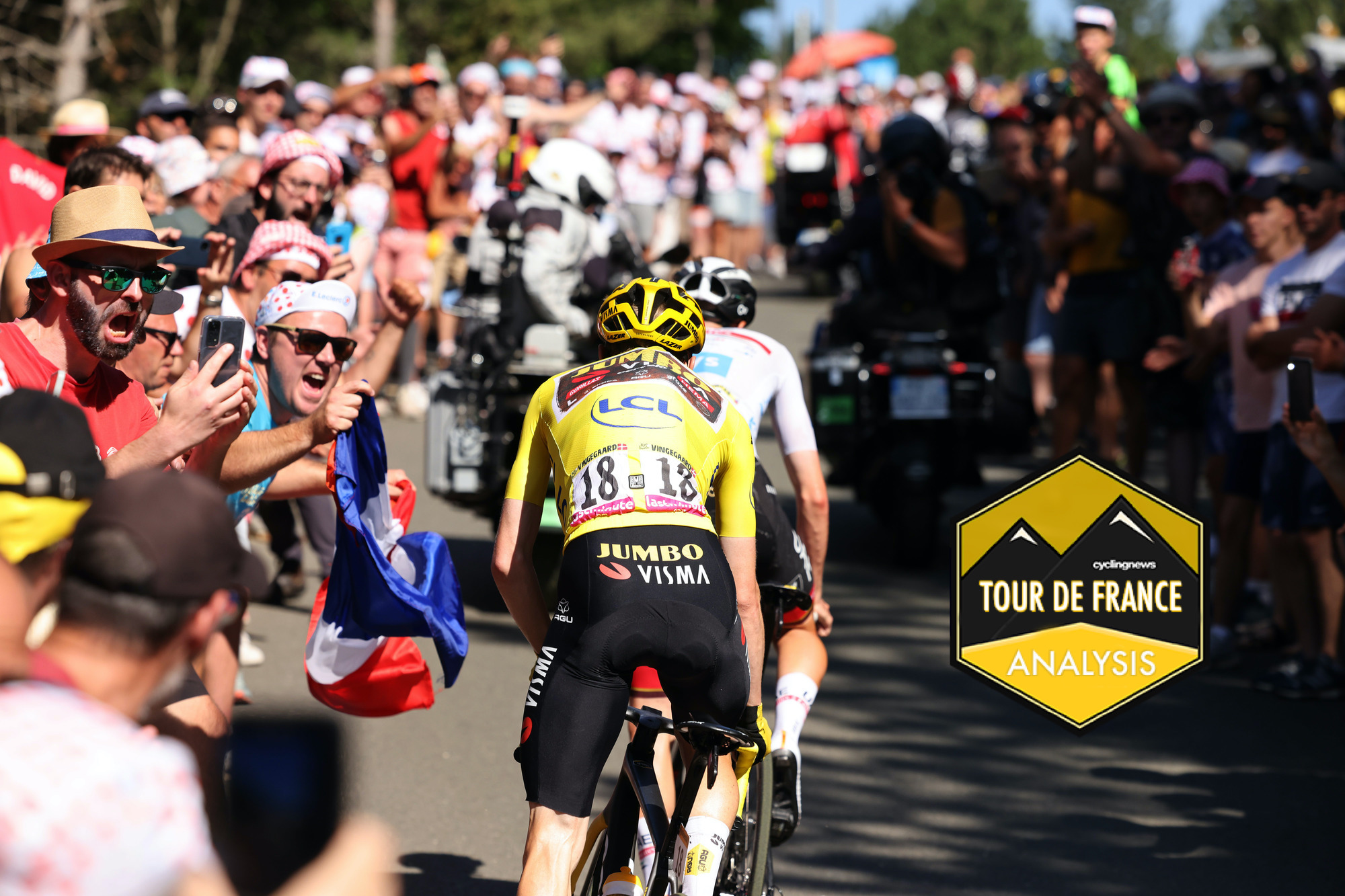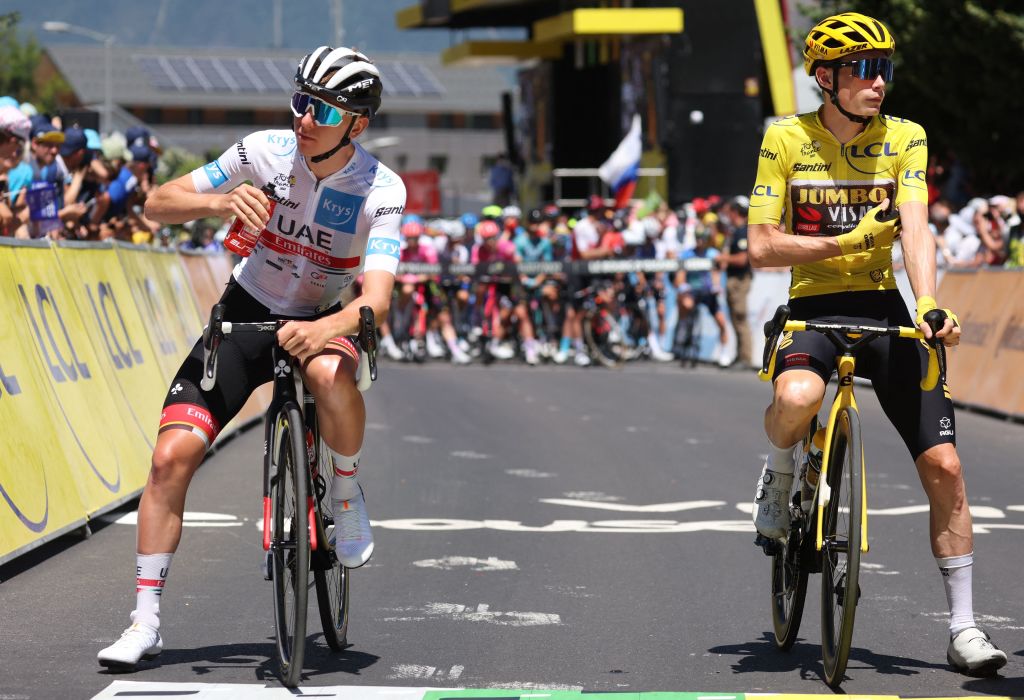Prize fight in the Pyrenees – Vingegaard versus Pogacar for the Tour de France
Three rounds in the high mountains to the decide the race

On the day Tadej Pogačar sent Primož Roglič sprawling to the canvas atop La Planche des Belles at the end of the 2020 Tour de France, he became his sport’s undisputed heavyweight champion. In almost every outing since, he has seemed to produce dizzying combinations that left even the doughtiest of opponents feeling punch drunk. He has had close to an unblemished record in stage racing over the past two years, with eight overall victories from his last nine, and seemingly no real challenger in sight.
But now, just as Pogačar’s dominance was becoming monotonous, Jonas Vingegaard has emerged as the Frazier to his Ali. The Dane already performed the rare feat of laying a glove on Pogačar when he briefly distanced him atop Mont Ventoux en route to second overall on last year’s Tour, but that warning shot came long after a boxing referee would already have stopped the fight. An unbloodied Pogačar still reached Paris with a lead of more than five minutes over Vingegaard.
This time around, Vingegaard has successfully weathered Pogačar’s onslaught in the opening week of the Tour and then delivered a pivotal knockdown on the Col du Granon to take the yellow jersey off his shoulders. Since moving into the overall lead, Vingegaard dealt comfortably with Pogačar’s jabs on the Alpe d’Huez and the Col de la Croix Neuve, rounds that most judges would have scored in the Dane’s favour.
The overall standings tell their own story as the Tour enters its final week, with Vingegaard carrying a lead of 2:22 over Pogačar. Nobody, not even Pogačar himself, could argue that Vingegaard hasn’t been full value for that advantage. The time was all amassed in a dizzying 5km atop the Granon, but the damage was already done by his Jumbo-Visma team’s all-out assault over the Télégraphe and Galibier.
Vingegaard’s Jumbo-Visma guard initially looked equipped to marshal him all the way to Paris in yellow, but his defences have been diminished considerably by the abandons of Roglič and Steven Kruijswijk on Sunday. Jumbo-Visma, like Pogačar’s UAE Team Emirates, are now down to just six riders. Despite the gifts of Wout van Aert and Sepp Kuss, this Tour looks increasingly like a head-to-head contest between its two heaviest hitters. Or, as Pogačar’s manager Mauro Gianetti put it: “The race will be decided between the leaders in the big climbs.”
Before the Tour began, Pogačar would undoubtedly have accepted those terms of engagement. In 2020, after all, he was all but bereft of climbing teammates as he took on an imposing Jumbo-Visma squad, yet he still reached Paris in yellow. The problem this time, however, is that Pogačar no longer has the luxury of knowing for sure that he is the best rider here.
For the first time in his Tour career, it seems that Pogačar is being called upon to perform the rare alchemy of winning yellow in Paris without necessarily being the strongest rider in the race. Alberto Contador was the modern master of that endeavour, somehow bending races like the 2008 Giro, the 2012 Vuelta and the (later revoked) 2010 Tour to his will when it seemed as though he had met his match. Invention, as much as power, will be required if Pogačar is to unseat Vingegaard.
Get The Leadout Newsletter
The latest race content, interviews, features, reviews and expert buying guides, direct to your inbox!
This is, by any measure, the biggest test of Pogačar’s career. As Cristiano Gatti argued on Tuttobici on Monday, failure to win this Tour would not suddenly “demote Pogačar to the category of ‘ordinary’ champions.” But winning from this situation would constitute the most remarkable feat of a career that has already routinely made the miraculous seem mundane.
The immovable mountains

In his press conference on Monday’s rest day in Carcassonne, Pogačar echoed the same pledge as he made after losing the yellow jersey on the Col du Granon. “I need to attack on every climb and try to make up time,” he said. The problem, of course, is that Vingegaard hasn’t been rattled by his attacks on this Tour. The burning question is whether that will change in the Pyrenees over the next three days.
The rest day certainly came at an opportune time for Vingegaard, who was a faller during Sunday’s stage to Carcassonne. He will have been glad of the chance to recover from his injuries – “I’m good, just some abrasions on my left arm” – and, above all, to regroup after the loss of Roglič and Kruijswijk.
Pogačar will test both Vingegaard’s recovery and the solidity of his team, starting on stage 16 to Foix. His aggression will surely be concentrated in the final two climbs of the day, the category 1 ascents of the Port de Lers (11.4km at 7%) and the wickedly steep Mur de Péguère (9.3km at 7.9%). The gradient on the Péguère stays in double digits for the final 4km, with pitches of 18%, and though the summit comes some 27km from the finish in Foix, that detail is unlikely to deter Pogačar, a rider for whom none of the rules seem to apply.
Two more opportunities follow in quick succession, and the brevity of stage 17 – 129.7km from Saint-Gaudens to Peyragudes – lends itself to a breathless afternoon of the kind seen over the Galibier last week. The category 1 Col d’Aspin (12km at 6.5%) is followed by the category 2 Houquette d’Ancizan (8.2km at 5.1%) and the category 1 Col de Val Louron-Azet (10.7km at 6.8%) before the summit finish at Peyragudes (8km at 7.8%). The staccato succession of climbs could tear the race asunder. The head-to-head could begin very early.
“The racing in the Pyrenees is more explosive than in the Alps because the valleys between the climbs are shorter,” warned Romain Bardet (DSM), currently 4th at 3:01. “There is the possibility of a lot of damage.”
The sheer accumulation of fatigue should also make itself felt by the time the race hits its final mountain stage from Lourdes to Hautacam on Thursday. “It can all change on the last day in the Pyrenees, because that’s the super-hard day,” said Geraint Thomas (Ineos Grenadiers), third at 2:43.
The opening half of stage 18 is relatively flat, but three passes are shoehorned into its final 83km, starting with the hors categorie Aubisque (16.4km at 7.1%). The Col de Spandelles (10.3km at 8.3%) serves the prelude to the wicked summit finish at Hautacam (13.6km at 7.8%), site of some rather dubious miracles in Tours past.
If Pogačar can’t recoup his losses on Vingegaard across the troika of stages in the Pyrenees, Saturday’s 40km time trial to Rocamadour presents a final opportunity, but he must narrow the gap considerably from 2:22 if he is to emulate the late heist, late the performed on Roglic on the corresponding stage in 2020. As things stand, Pogačar would need to gain a little over 3.5 seconds per kilometre in that test to seize yellow, a target beyond even his considerable reach.
Tadej Pogacar and Jonas Vingegaard entered the Tour as major favourites, here's our video assessment of the main contenders ahead of the race
The variables on the road
Pogačar and Vingegaard are not duelling in a vacuum, of course. The relative strength of their teams, despite Gianetti’s assessment, might yet play a part. In Pogačar’s corner, Rafal Majka and Brandon McNulty look in crescendo. Vingegaard, meanwhile, is now more heavily reliant on Van Aert and Kuss.
To this point, however, the leading pair have been all but in race of their own. Their startling strength has all but dissuaded the other podium contenders from attacking, with the notable exceptions of Bardet and Nairo Quintana on the Granon. If Pogačar and Vingegaard mark one another too heavily, mind, it might yet open unexpected opportunities for the men directly behind them, as was the case when Contador and Andy Schleck kept one another company around these parts in 2010.
“At some point, Ineos will risk something with one of those two guys,” Bardet said of Yates and Thomas. “They’re looking good and super consistent, so I think they will also try to shake things up a bit.”
The third external factor that might tip the scales is the weather. When Pogačar seized yellow in the rain at Le Grand Bornand last year and then endured his worst day atop Mont Ventoux, a narrative took hold that the Slovenian struggled in the heat. France, like the rest of Europe, is enduring a searing heat wave that looks set to endure through the Pyrenees. Advantage Vingegaard? Not so fast, says the Pogačar camp.
“I’ve never seen Tadej suffer with the heat at all, I don’t think he has any more problems with it than anyone else,” Gianetti insisted. “I don’t know where that idea came from.”
Perhaps the absence of a close rival for Pogačar last year meant that semblance of weakness was always likely to be magnified in a bid to bring tension to the narrative. Vingegaard has ensured there is no such problem this time around. Everything that happens in the Pyrenees revolves around the duel between Vingegaard and Pogačar.

Barry Ryan was Head of Features at Cyclingnews. He has covered professional cycling since 2010, reporting from the Tour de France, Giro d’Italia and events from Argentina to Japan. His writing has appeared in The Independent, Procycling and Cycling Plus. He is the author of The Ascent: Sean Kelly, Stephen Roche and the Rise of Irish Cycling’s Golden Generation, published by Gill Books.